Advances in Laser-Induced Acoustic Technology for Underwater Detection
Abstract
1. Introduction
2. Mechanisms of LIAs
2.1. Thermoelastic Mechanism
2.2. Phase-Change Vaporization Mechanism
2.3. Laser-Induced Optical Breakdown Mechanism
2.4. Cross-Medium Propagation Characteristics of LIA Waves
3. Influence of Laser Parameters on Acoustic Signal Characteristics
3.1. Selection of Laser Wavelength
3.2. Influence of Laser Pulse Duration and Single-Pulse Energy
4. LIA Detection Systems
5. Discussion
6. Conclusions
Author Contributions
Funding
Data Availability Statement
Conflicts of Interest
References
- Aussel, J.D.; Le Brun, A.; Baboux, J.C. Generating acoustic waves by laser: Theoretical and experimental study of the emission source. Ultrasonics 1988, 26, 245–255. [Google Scholar] [CrossRef]
- Kaushal, H.; Kaddoum, G. Underwater Optical Wireless Communication. IEEE Access 2016, 4, 1518–1547. [Google Scholar] [CrossRef]
- Zemlyanov, A.A.; Alexander, A.; Bochkarev, N.N.; Nikolay, N.; Kabanov, A.M.; Andrey, M.; Pogodaev, V.A.; Vitalii, A. Generation of acoustic pulses on the natural centers of absorption with propagation CO2 laser radiation on atmospheric paths. Proc. SPIE Int. Soc. Opt. Eng. 2001, 4341, 202–209. [Google Scholar]
- Anisimov, S.I. Vaporization Of Metal Absorbing Laser Radiation. In 30 Years of the Landau Institute—Selected Papers; World Scientific Series in 20th Century Physics; World Scientific: Singapore, 1996; pp. 14–15. [Google Scholar]
- Antonelli, L.; Blackmon, F. Experimental demonstration of remote, passive acousto-optic sensing. J. Acoust. Soc. Am. 2004, 116, 3393–3403. [Google Scholar] [CrossRef]
- Ma, Y.L.; Yang, Y.X.; He, Z.Y.; Yang, K.D.; Sun, C.; Wang, Y.M. Theoretical and practical solutions for high-order superdirectivity of circular sensor arrays. IEEE Trans. Ind. Electron. 2013, 60, 203–209. [Google Scholar] [CrossRef]
- Yang, Y.X.; Zhou, J.B.; L, M.Y.; Hou, X.H.; Yang, L.; Xie, L.; Wang, L.; Shen, H.; Liu, X.H.; Lei, B.; et al. Underwater acoustics: Current status and future trends. Tech. Acoust. 2025, 44, 309–332. [Google Scholar]
- Du, Z.P.; Chen, G.; Wang, D. Foreign sonar technology development research summary. Ship Sci. Technol. 2019, 41, 145–151. [Google Scholar]
- Zhang, G.; Zhang, L.; Wang, Y.; Ma, Y.; Zhou, X.; Yu, Y. Spatiotemporal Analysis of Sonar Detection Range in Luzon Strait. J. Mar. Sci. Eng. 2024, 12, 1191. [Google Scholar] [CrossRef]
- Jia, Y.J.; Wang, P.B.; Wei, H.K.; Chen, Q.; Hu, Y.H. Research on high-resolution processing of frequency modulation combined signal for active sonar detection. Front. Phys. 2025, 13, 1542037. [Google Scholar] [CrossRef]
- Wang, X.; Zhang, Z.; Shang, X. Research on Improved YOLO11 for Detecting Small Targets in Sonar Images Based on Data Enhancement. Appl. Sci. 2025, 15, 6919. [Google Scholar] [CrossRef]
- Xie, L.; Sun, C.; Kong, D.Z. Matched-phase weighting beamformer to improve the gain of a long linear array in the range-dependent ocean waveguide. IEEE Access 2020, 8, 177437–177446. [Google Scholar] [CrossRef]
- Lu, J.Y.; Yang, Y.X.; Yang, L. An efficient off-grid direction-of-arrival estimation method based on inversefree sparse Bayesian learning. Appl. Acoust. 2023, 211, 109521. [Google Scholar] [CrossRef]
- Fillinger, L.; Hunter, A.J.; Zampolli, M.; Clarijs, M.C. Passive Acoustic Detection of Closed-Circuit Underwater Breathing Apparatus in an Operational Port Environment. J. Acoust. Soc. Am. 2012, 132, EL310–EL316. [Google Scholar] [CrossRef]
- Sun, Y.C.; Chen, W.Y.; Wang, P.B. Review of research on the characteristics of underwater acoustic signal of frogman. Tech. Acoust. 2022, 41, 479–488. [Google Scholar]
- Dong, L.; Li, N.; Xie, X.; Bao, C.; Li, X.; Li, D. A Fast Analysis Method for Blue-Green Laser Transmission through the Sea Surface. Sensors 2020, 20, 1758. [Google Scholar] [CrossRef] [PubMed]
- Collin, A.; Archambault, P.; Long, B. Mapping the Shallow Water Seabed Habitat with the SHOALS. IEEE Trans. Geosci. Remote Sens. 2008, 46, 2947–2955. [Google Scholar] [CrossRef]
- Tulldahl, H.M.; Philipson, P.; Kautsky, H.; Wikstrom, S.A. Sea Floor Classification with Satellite Data and Airborne Lidar Bathymetry. In Ocean Sensing and Monitoring V, Proceeding of the SPIE, the International Society for Optics and Photonics, Baltimore, MD, USA, 30 April–1 May 2013; Hou, W.W., Arnone, R.A., Eds.; SPIE-Int Soc Optical Engineering: Bellingham, WA, USA, 2013; Volume 8724, p. UNSP 87240B. ISBN 978-0-8194-9515-0. [Google Scholar]
- Li, X.; Miao, X.; Qi, X.; Han, X. Research on the propagation characteristics of blue-green laser through sea surface with foams. Optik 2018, 170, 265–271. [Google Scholar] [CrossRef]
- Birkebak, M.; Eren, F.; Pe’eri, S.; Weston, N. The Effect of Surface Waves on Airborne Lidar Bathymetry (ALB) Measurement Uncertainties. Remote Sens. 2018, 10, 453. [Google Scholar] [CrossRef]
- Ma, J.; Lu, T.; He, Y.; Jiang, Z.; Hou, C.; Li, K.; Liu, F.; Zhu, X.; Chen, W. Compact Dual-Wavelength Blue-Green Laser for Airborne Ocean Detection Lidar. Appl. Opt. 2020, 59, C87–C91. [Google Scholar] [CrossRef]
- Hostetler, C.A.; Behrenfeld, M.J.; Hu, Y.; Hair, J.W.; Schulien, J.A. Spaceborne Lidar in the Study of Marine Systems. Annu. Rev. Mar. Sci. 2018, 10, 121–147. [Google Scholar] [CrossRef]
- Wu, Z.; Li, H.; Yang, F.; Li, S.; Gao, J.; Zhang, W.; Jin, S.; Huo, G.; Shang, J.; Yang, K.; et al. High-Resolution Seafloor Topography and Morphology—Detection, Processing Theory and Techniques; Science Press: Beijing, China, 2017; ISBN 978-7-03-052904-6. [Google Scholar]
- Ng, R.; Sachat, A.; Cespedes, F.; Poblet, M.; Madiot, G.; Jaramillo-Fernandez, J.; Xiao, P.; Florez, O.; Sledzinska, M.; Sotomayor-Torres, C.; et al. Excitation and Detection of Acoustic Phonons in Nanoscale Systems. Nanoscale 2022, 14, 13428–13451. [Google Scholar] [CrossRef]
- Ikei, A.; Sampath, K. Remote Operation of a Single-Point LDV System to Acquire 2D Measurements. arXiv 2021, arXiv:2102.13031. [Google Scholar] [CrossRef]
- Jin, Y.; Dollevoet, R.; Li, Z. Removing Speckle Noise from the Signals of a Laser Doppler Vibrometer on Moving Platforms (LDVom) by Ensemble Empirical Mode Decomposition. Meas. Sci. Technol. 2022, 33, 125205. [Google Scholar] [CrossRef]
- Yuan, K.; Zhu, W.D. A Novel General-Purpose Three-Dimensional Continuously Scanning Laser Doppler Vibrometer System for Full-Field Vibration Measurement of a Structure with a Curved Surface. J. Sound Vib. 2022, 540, 117274. [Google Scholar] [CrossRef]
- Tsubouchi, K.; Yoshida, S.; Satoh, T.; Ikeuchi, K. A Fiber LDV System for Measurement of Atomized Droplets Away from the Trailing Edge of a Fixed Blade in Two-Phase Flow. JSME Int. J. Ser. 2 Fluids Eng. Heat Transf. Power Combust. Thermophys. Prop. 1990, 33, 511–516. [Google Scholar] [CrossRef]
- Chen, H. Research on Signal Processing Methods of Laser Doppler Velocimetry System. Master’s Thesis, Qingdao University of Science and Technology, Qingdao, China, 2023. [Google Scholar]
- Chen, L.J.; Xi, C.B.; Zhou, J.; Nie, X.M.; Jin, S.L.; Luo, H. Research and Flight Test on Airborne Laser Doppler Velocimeter for Unmanned Aerial Vehicles. Chin. J. Opt. 2023, 43, 65–74. [Google Scholar]
- Guardato, S.; Riccio, R.; Janneh, M.; Bruno, F.A.; Pisco, M.; Cusano, A.; Iannaccone, G. An Innovative Fiber Optic Hydrophone for Seismology: Testing Detection Capacity for Very Low-Energy Earthquakes. Sensors 2023, 23, 3374. [Google Scholar] [CrossRef]
- Li, M.; Yu, Y.; Lu, Y.; Hu, X.; Wang, Y.; Qin, S.; Lu, J.; Yang, J.; Zhang, Z. Optical Microfiber All-Optical Phase Modulator for Fiber Optic Hydrophone. Nanomaterials 2021, 11, 2215. [Google Scholar] [CrossRef]
- Zhang, Y.; Meng, Z.; Wang, J.; Chen, M.; Liang, Y.; Hu, X. The Two-Stage Suspension System of the Fiber Optic Vector Hydrophone for Isolating the Vibration from the Mooring Rope. Sensors 2022, 22, 9261. [Google Scholar] [CrossRef]
- Yu, Z.; Cai, Y.; Mo, D. Comparative Study on Noise Reduction Effect of Fiber Optic Hydrophone Based on LMS and NLMS Algorithm. Sensors 2020, 20, 301. [Google Scholar] [CrossRef]
- Sun, X.Y.; Guang, D.; Deng, C.Y.; Yu, B.L. Design and test of fiber optic hydrophone element for deep-sea application. Opt. Precis. Eng. 2025, 33, 1550–1557. [Google Scholar]
- Hu, Y.; Yan, Y.; Wang, L.; Qian, X. Non-Contact Vibration Monitoring of Power Transmission Belts Through Electrostatic Sensing. IEEE Sens. J. 2016, 16, 3541–3550. [Google Scholar] [CrossRef]
- Zhao, J.; Wang, M.R.; Xu, D.G.; Li, J.X.; Wang, X.; Yang, Y.G. Underwater Transmission of Pulsed Laser-acoustic Signals and Acoustic Scattering Characteristics of Metallic Targets. Adv. Lasers Optoelectron. 2025, 62, 06. [Google Scholar]
- Du, Y.C.; Cao, X.L.; Yang, Y.G.; Zhang, T.; Yuan, J.Q.; Cui, T.Y.; Yao, J.Q. Acoustic Signal Reconstruction Across Water–Air Interface Through Millimeter-Wave Radar Micro-Vibration Detection. J. Mar. Sci. Eng. 2024, 12, 1989. [Google Scholar] [CrossRef]
- Zhang, T.C.; Cao, X.L.; Du, Y.C.; Yao, J.Q. Study on time-frequency domain characteristics and cross-media communication of laser acoustic signals based on optical breakdown mechanism. Phys. Scr. 2025, 100, 035402. [Google Scholar] [CrossRef]
- Li, P.; Zhao, Y.; Zhou, Z.Q.; Zhang, P.H.; Bai, X.; Ma, J. Research on laser induced acoustic detection of trans-media aerial-underwaterInfrared and Laser Engineering. Infrared Laser Eng. 2021, 50, 20200310. [Google Scholar]
- Fitzpatrick, A.; Singhvi, A.; Arbabian, A. An Airborne Sonar System for Underwater Remote Sensing and Imaging. IEEE Access 2020, 8, 189945–189959. [Google Scholar] [CrossRef]
- Egerev, S.V. In search of a noncontact underwater acoustic source. Acoust. Phys. 2003, 49, 51–61. [Google Scholar] [CrossRef]
- Hickman, G.D.; Edmonds, J.A. An Experimental Facility for Laser/Acoustic Applications. NASA STI/Recon Tech. Rep. N. 1981, 82, 26657. [Google Scholar]
- Hickman, G.D.; Edmonds, J.A. Laser-acoustic measurements for remotely determining bathymetry in shallow turbid waters. J. Acoust. Soc. Am. 1983, 73, 840–843. [Google Scholar] [CrossRef]
- Blackmon, F.A.; Antonelli, L.T. Experimental detection and reception performance for uplink underwater acoustic communication using a remote, in-air, acousto-optic sensor. IEEE J. Ocean. Eng. 2006, 31, 179–187. [Google Scholar] [CrossRef]
- Bidin, N.; Hossenian, R.; Duralim, M.; Krishnan, G.; Marsin, F.; Nughro, W.; Zainal, J. Determination of hydrocarbon levels in water via LIAs wave. Opt. Lasers Eng. 2016, 79, 61–67. [Google Scholar] [CrossRef]
- Jukna, V.; Jarnac, A.; Milián, C.; Brelet, Y.; Carbonnel, J.; André, Y.-B.; Guillermin, R.; Sessarego, J.-P.; Fattaccioli, D.; Mysyrowicz, A.; et al. Underwater acoustic wave generation by filamentation of terawatt ultrashort laser pulses. Phys. Rev. 2016, 93, 063106. [Google Scholar] [CrossRef]
- Baimler, I.V.; Lisitsyn, A.B.; Gudkov, S.V. Water Decomposition Occurring During Laser Breakdown of Aqueous Solutions Containing Individual Gold, Zirconium, Molybdenum, Iron or Nickel Nanoparticles. Front. Phys. 2020, 8, 620938. [Google Scholar] [CrossRef]
- Yellaiah, J.; Kiran, P.P. Input pulse duration effect on laser-induced underwater acoustic signals. Appl. Opt. 2021, 60, 4582–4590. [Google Scholar] [CrossRef]
- Cui, G.; Li, R.; Tian, Z.; Sang, G. A Laser Remote Sensing Study for Detection of Under Water Acoustic Signals. Ship Sci. Technol. 2002, 24, 46–50. [Google Scholar]
- Cui, G.; Li, R.; Li, J. Research on LIA Technology and Its Application Prospects. Acoust. Electron. Eng. 1989, 2, 17–22. [Google Scholar]
- Li, R.; Cui, G.; Sang, G. Characteristics of Sound Impulse Induced by CO2 Laser in Water and its Transmission Lose. Ship Sci. Technol. 2002, 24, 41–45. [Google Scholar]
- Li, R.; Cui, G.; Yun, T.; Sang, G. Laser/acoustic remote sensing for underwater objects. Prog. Nat. Sci. 1996, 6, S755–S759. [Google Scholar]
- Li, R.; Cui, H. Application of Laser/Acoustic Technology in Anti-Stealth Submarine Detection. Ship Sci. Technol. 1995, 2, 11–14. [Google Scholar]
- Li, Q. Fundamental Research on Novel All-Fiber Photoacoustic Source for Underwater Communication. Ph.D. Thesis, National University of Defense Technology, Changsha, China, 2010. [Google Scholar]
- Wang, W.; Yang, Y.; Zhang, W. Pulsed-Laser-Sound-Signal Detection Based on Frequency-Domain Energy Dtector. Chin. J. Lasers 2019, 46, 53–61. [Google Scholar]
- Liu, Z. Research on Frequency Band Efficient Utilization of Underwateracoustic Communication Based on Chaos. Master’s Thesis, North University of China, Taiyuan, China, 2023. [Google Scholar]
- Wang, Y.; Wang, J.; Wu, R. Influences of liquids properties and absorbed energy on laser induced expanding sound. High Power Laser Part Beams 2009, 21, 998–1002. [Google Scholar]
- Wang, Y.; Wang, J.; Zong, S. Coincidence relation between laser pulse energy and hydroacoustic speciality. Laser Infrared 2008, 38, 981–984. [Google Scholar]
- Zong, S.; Wang, J.; Wang, Y. Experiment Investigation of Water Breakdown Characteristic by High Power Laser. Opto-Electron. Eng. 2008, 35, 68–72. [Google Scholar]
- Li, S.; Wu, R.; Wang, X.; Wang, J.; Zong, S. Properties of LIA signals transmission in liquid. Infrared Laser Eng. 2017, 46, 54. [Google Scholar]
- Sigrist, M.W. Laser generation of acoustic waves in liquids and gases. J. Appl. Phys. 1986, 60, R83–R122. [Google Scholar] [CrossRef]
- Zong, S.; Wang, J.; Wang, Y.; Miao, H. Laser-acoustic source characteristic and its application in ocean. Ying Yong Guang Xue 2008, 29, 408–411. [Google Scholar]
- Li, P. Research on the Method and Key Technology of Trans-media Detection Based on Laser Induced Acoustic Mechanism. Master’s Thesis, Qilu University of Technology, Shandong, China, 2021. [Google Scholar]
- Sigrist, M.W.; Kneubühl, F.K. Laser-generated stress waves in liquids. J. Acoust. Soc. Am. 1978, 64, 1652–1663. [Google Scholar] [CrossRef]
- Farrant, D.; Burke, J.; Dickinson, L.; Fairman, P.; Wendoloski, J. Opto-acoustic underwater remote sensing (OAURS)—An optical sonar? In Proceedings of the OCEANS 2010 IEEE, Sydney, Australia, 24–27 May 2010; pp. 1–7. [Google Scholar]
- Kiselev, V.D.; Maksimov, A.O. Dispersion deformation of optoacoustic pulses in the surface layer of the ocean. J. Appl. Mech. Tech. Phys. 1993, 34, 796–801. [Google Scholar] [CrossRef]
- Teslenko, V.S. Electrical, laser and acoustic breakdown of a liquid, resemblance and distinctions. In Proceedings of the 2002 IEEE 14th International Conference on Dielectric Liquids, ICDL 2002, Graz, Austria, 7–12 July 2002; pp. 163–166. [Google Scholar]
- Li, R.; Cui, G.; Tian, Z. Laser-Acoustic Remote Sensing Technology; National Defense Industry Press: Beijing, China, 2003. [Google Scholar]
- He, Q.; Zong, S. Analysis and thinking about the development of air and water crossed laser acoustic technology. Laser Infrared 2019, 49, 3–8. [Google Scholar]
- Chen, X. Studies on Mechanisms of the Interaction Between High-Power Laser and Matter in Water. Ph.D. Thesis, Nanjing University of Science and Technology, Nanjing, China, 2004. [Google Scholar]
- Zhao, R. Studies on Characteristic of Laser-induced Plasma Shock Wave Evolution and Cavitation Bubble Dynamics. Ph.D. Thesis, Nanjing University of Science and Technology, Nanjing, China, 2007. [Google Scholar]
- Zong, S.; Wang, J.; Ma, Z.; Wang, Y. Erosion characteristics of laser bubble collapse in the vicinity of a solid boundary. Chin. J. Opt. 2010, 30, 885–892. [Google Scholar]
- Li, S.; Liu, X.; Wang, J.; Zong, S.; Shen, Z.; Ni, X. Influence of bubble content on spectrum properties of laser-induced cavitation bubble collapse sound waves in liquid. Qiang Ji Guang Yu Li Zi Shu 2012, 24, 1067–1070. [Google Scholar]
- Li, S.Y.; Liu, T.; Wang, J.A.; Zong, S.G. Properties of laser-induced two-bubble sound waves. Guang Dian Zi Ji Guang 2012, 23, 2440–2445. [Google Scholar]
- Li, S.; Wang, X.; Wang, J.; Zong, S.; Liu, T. Experimental investigation of influence of ambient pressure on properties of laser-induced cavitation bubble collapse sound waves. Infrared Laser Eng. 2015, 44, 879–883. [Google Scholar]
- Thorp, W.H. Analytic Description of the Low-Frequency Attenuation Coefficient. J. Acoust. Soc. Am. 1967, 42, 270. [Google Scholar] [CrossRef]
- Wang, L.V. Photoacoustic Imaging and Spectroscopy; CRC Press eBooks; CRC Press: Boca Raton, FL, USA, 2017; 536p. [Google Scholar] [CrossRef]
- Hoelen, C.G.A.; de Mul, F.F.M. A new theoretical approach to photoacoustic signal generation. J. Acoust. Soc. Am. 1999, 106, 695–706. [Google Scholar] [CrossRef]
- Ma, B.; Firouzi, K.; Brenner, K.; Khuri-Yakub, B.T. Wide Bandwidth and Low Driving Voltage Vented CMUTs for Airborne Applications. IEEE Trans. Ultrason. Ferroelectr. Freq. Control 2019, 66, 1777–1785. [Google Scholar] [CrossRef]
- Park, K.; Khuri-Yakub, B.T. 3-D airborne ultrasound synthetic aperture imaging based on CMUT. Ultrasonics 2013, 53, 1355–1362. [Google Scholar] [CrossRef]
- Nan, H.; Boyle, K.C.; Apte, N.; Aliroteh, M.S.; Bhuyan, A.; Nikoozadeh, A.; Khuri-Yakub, B.T.; Arbabian, A. Non-contact thermoacoustic detection of embedded targets using airborne-CMUT. Appl. Phys. Lett. 2015, 106, 084101. [Google Scholar] [CrossRef]
- Boyle, K.C.; Nan, H.; Khuri-Yakub, B.T.; Arbabian, A. Noncontact thermoacoustic detection of targets embedded in dispersive media. In Proceedings of the SPIE Security + Defence, Edinburgh, UK, 26–29 September 2016; p. 99880H. [Google Scholar]
- Kirk, J.C. A Discussion of Digital Processing in Synthetic Aperture Radar. IEEE Trans. Aerosp. Electron. Syst. 1975, AES-11, 326–337. [Google Scholar] [CrossRef]
- Blackmon, F.; Antonelli, L.; Carapezza, E. Remote, aerial, opto-acoustic communications and sonar. Proc. SPIE Int. Soc. Opt. Eng. 2005, 5778, 800–808. [Google Scholar]
- He, D.M.; Scheps, R. High-power Nd: YAG-generated underwater sound source for air-submarine communication. Proc. SPIE Int. Soc. Opt. Eng. 1999, 3613, 83–92. [Google Scholar]
- Blackmon, F.; Antonelli, L. Experimental demonstration of multiple pulse nonlinear optoacoustic signal generation and control. Appl. Opt. 2005, 44, 103–112. [Google Scholar] [CrossRef]
- Zong, S.; Wang, J. Both wavelength laser fusion for detecting underwater target. Opt. Commun. Technol. 2008, 32, 53–56. [Google Scholar]
- Zhao, A.; Dong, H.; Sun, G.; Hui, J.; Cai, P. A laser-acoustic system for underwater target detection. Sheng Xue Ji Shu 2009, 28, 14–16. [Google Scholar]
- Zong, S.; Wang, J.; Ma, M.; Ma, Z. Investigation of LIAs signal for target detection. Chin. J. Lasers 2010, 37, 1332–1337. [Google Scholar] [CrossRef]
- Liu, T.; Wang, J.; Zong, S.; Liang, S. Design of underwater target detector by laser-induced sound signal. Infrared Laser Eng. 2012, 41, 1767–1771. [Google Scholar]
- Ye, J. Underwater Target Estimation Based on Wideband LIA Source. Master’s Thesis, Zhejiang University, Hangzhou, China, 2015. [Google Scholar]
- Zhao, Y.; Li, P.; Zhang, P.; Zhou, Z.; Bai, X.; Ma, J. Underwater Small Target Detection Method of LIA SAFT Based on PSM Algorithm. Chin. J. Lasers 2022, 49, 0909001. [Google Scholar]
- Spagnolo, G.S.; Cozzella, L.; Leccese, F. Underwater Optical Wireless Communications: Overview. Sensors 2020, 20, 2261. [Google Scholar] [CrossRef]
- Mahmud, M.; Islam, S.; Ahmed, A.; Younis, M.; Choa, F.S. Cross-Medium Photoacoustic Communications: Challenges, and State of the Art. Sensors 2022, 22, 4224. [Google Scholar] [CrossRef]
- Chen, Q.M. Research of Acoustics Induced by Pulsed CO2, Laser in Water. Ph.D. Thesis, Huazhong University of Science and Technology, Wuhan, China, 2009. [Google Scholar]
- Hu, X.; Chen, M.; Zhang, X.; Rao, J.; Li, S.; Song, X. MFCA-Transformer: Modulation Signal Recognition Based on Multidimensional Feature Fusion. Sensors 2025, 25, 5061. [Google Scholar] [CrossRef] [PubMed]
- Cao, Y.; Hu, R.; Shi, W.; Zhou, R. Experimental Study on Near-Wall Laser-Induced Cavitation Bubble Micro-Dimple Formation on 7050 Aluminum Alloy. Water 2024, 16, 1410. [Google Scholar] [CrossRef]

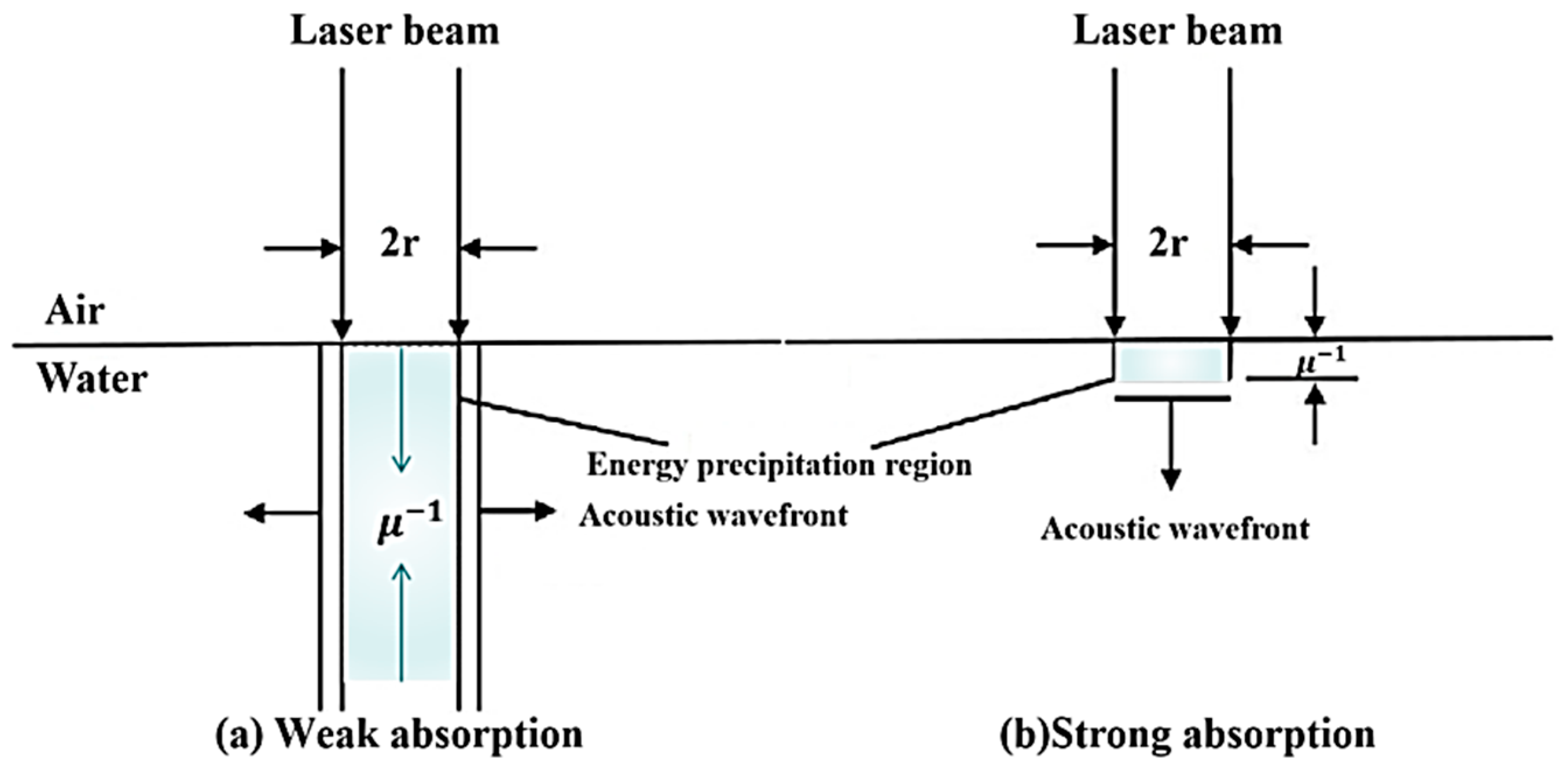
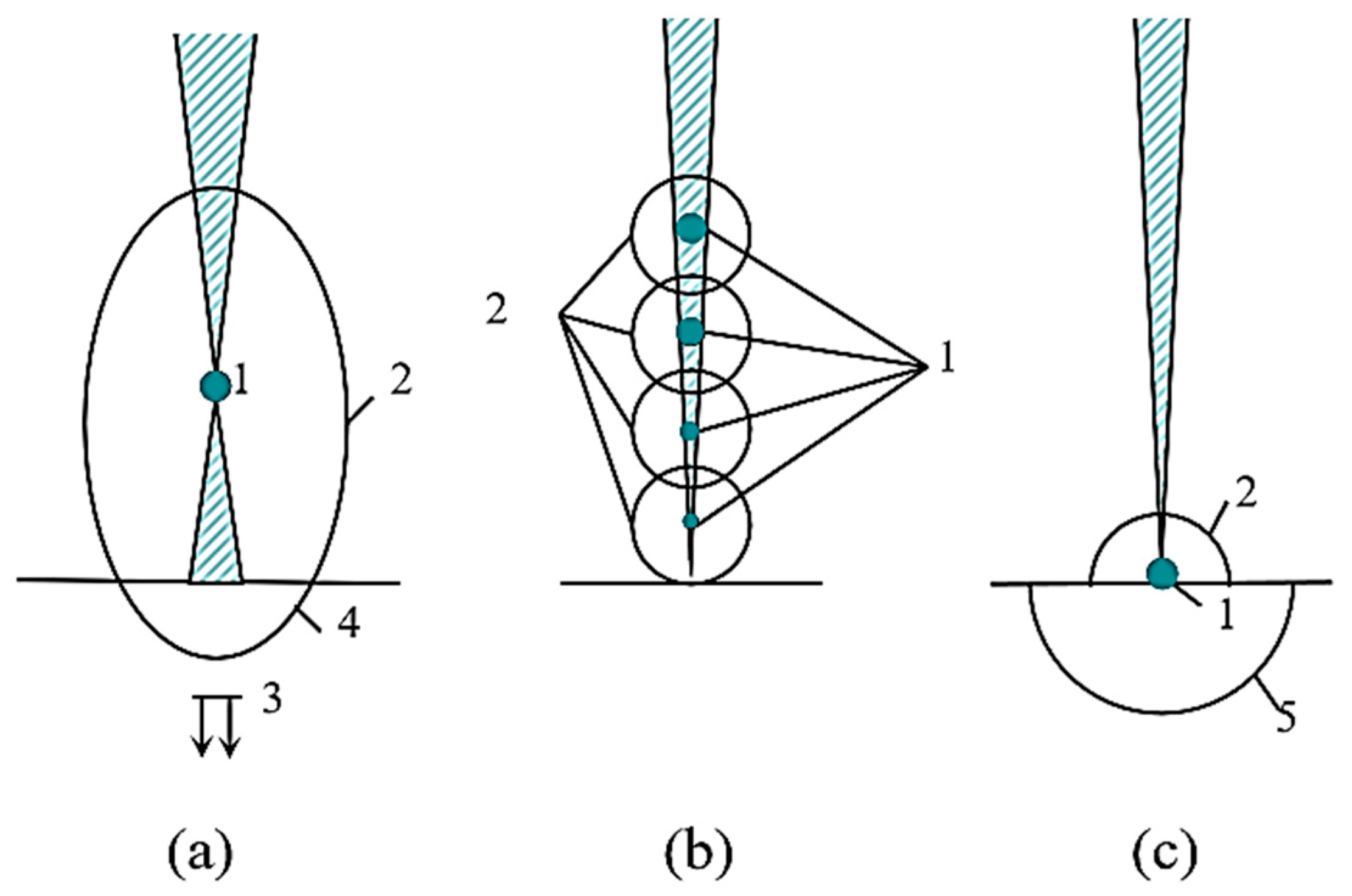
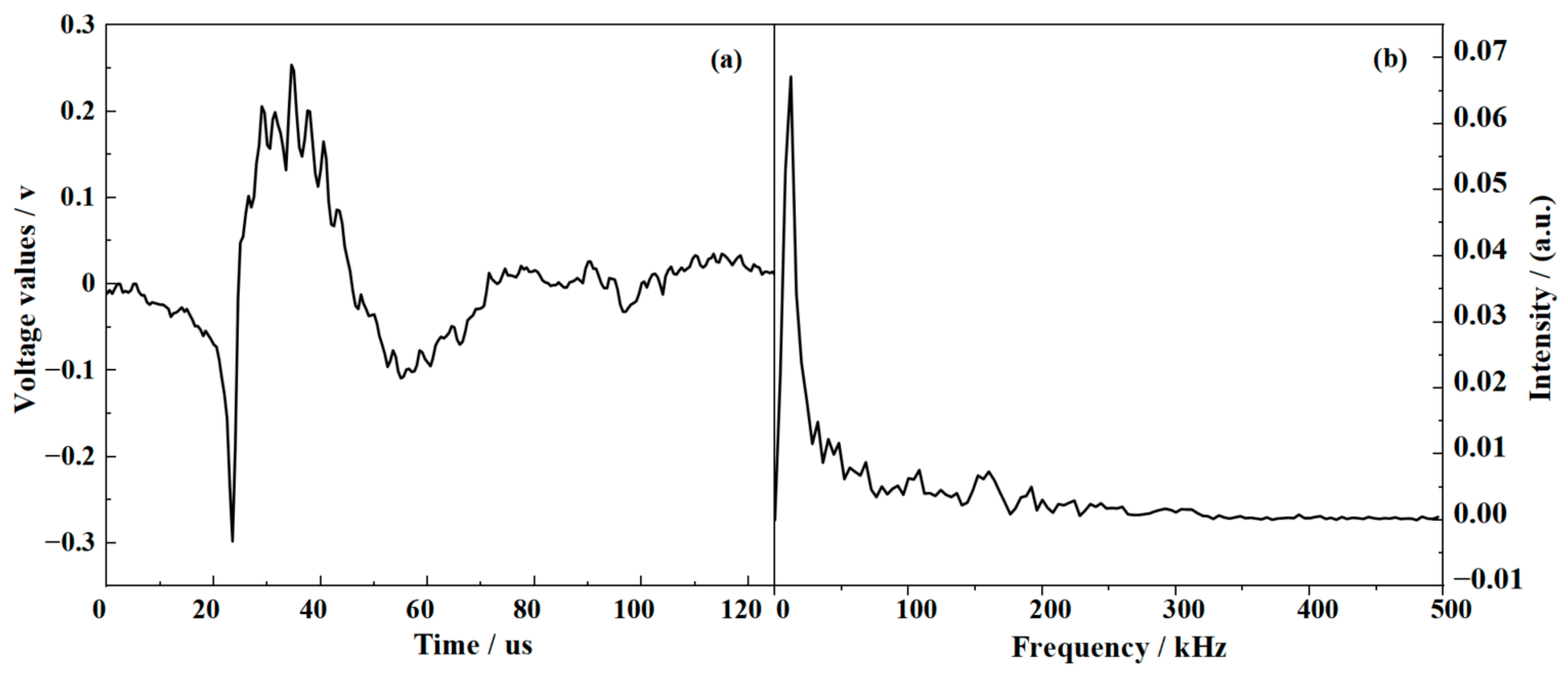
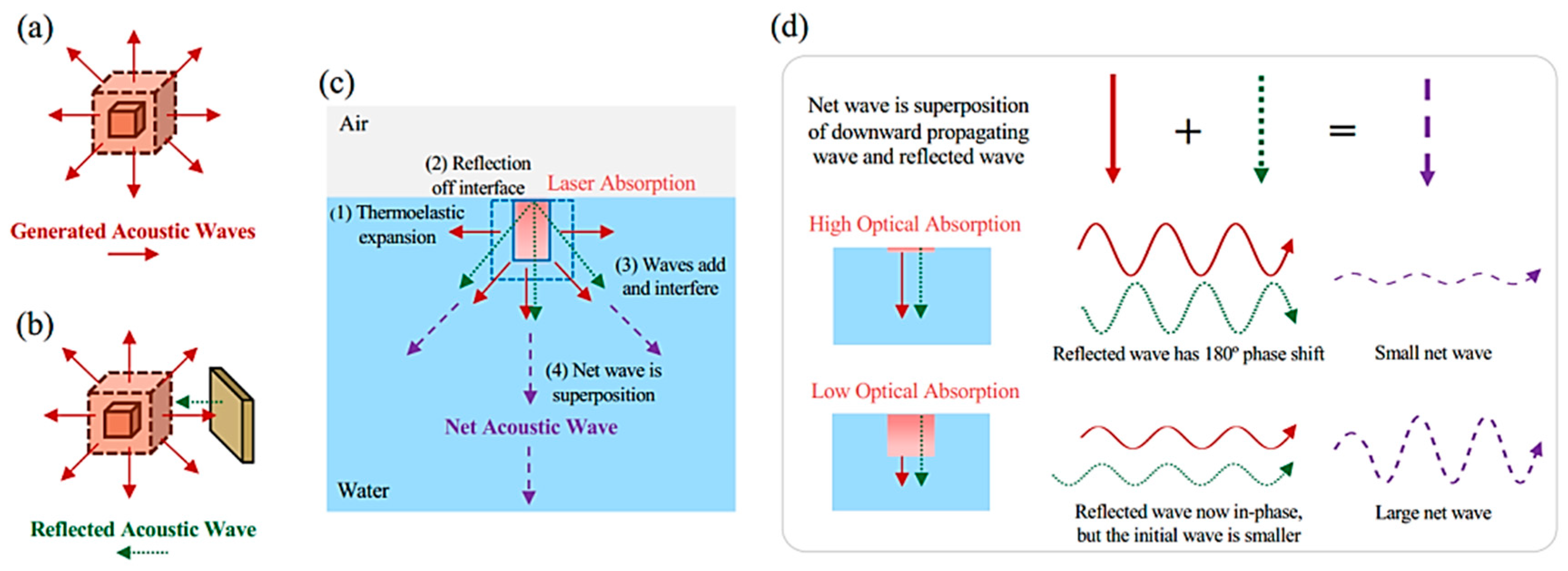
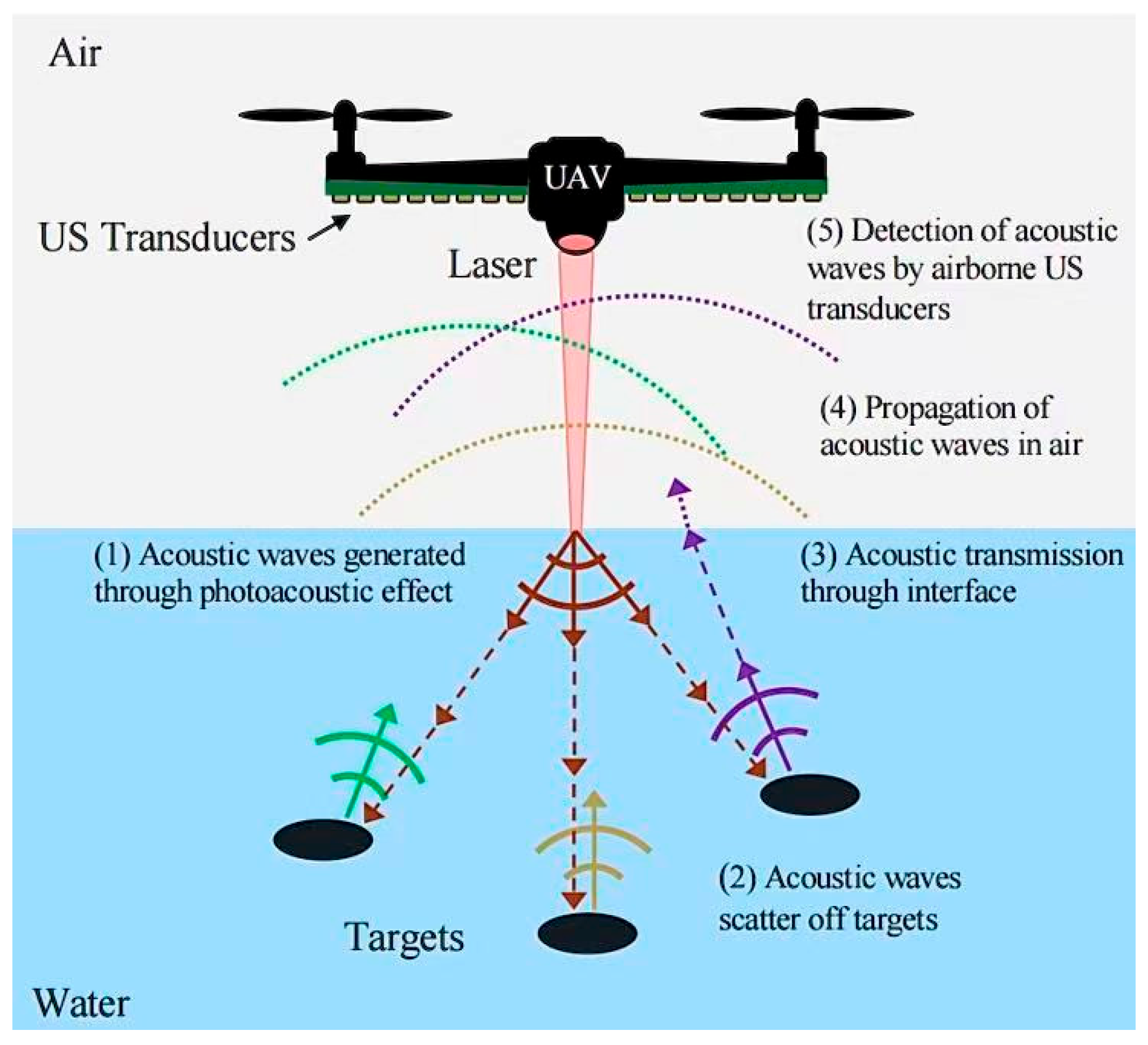

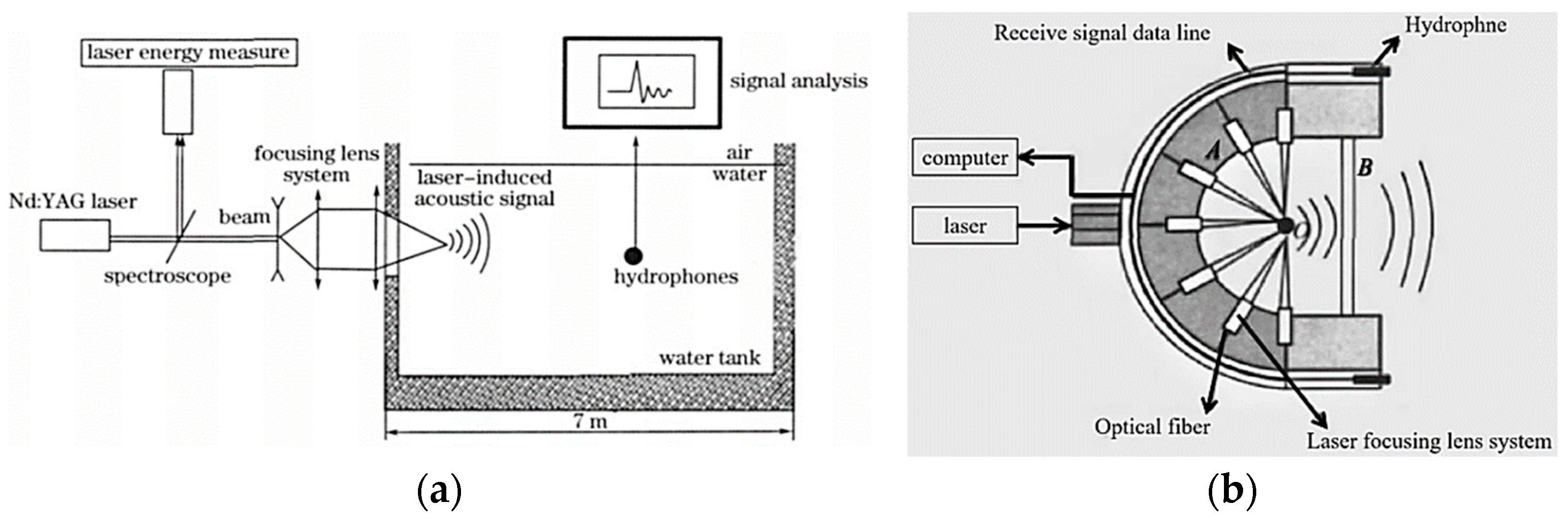

| Method | Typical Platforms | Strengths | Core Constraints | Representative Performance | |
|---|---|---|---|---|---|
| Detection Depth | Resolution | ||||
| Active Sonar | Shore-based; surface ships; submarines; airborne; unmanned surface Vehicle (USV) and unmanned underwater Vehicle (UUV) [6] | Active emission; long-range; high-resolution [7] | Operational exposure; high energy demand; sensitivity to environmental conditions [8] | Over 10 km given favorable sound-channel conditions [9,10] | At 220–260 kHz, Synthetic aperture sonar (SAS) can deliver 3 cm × 2 cm imaging resolution [11] |
| Passive Sonar | Covert operation, low-power, and persistent surveillance capability [12,13] | Limited detection range; incomplete information; and constrained sensitivity to low-acoustic-signature targets [14] | In general, the propagation depth is within 200 m [15,16] | / | |
| Airborne Blue-Green LiDAR | Fixed wing; helicopters; unmanned aerial vehicles (UAVs), satellites [17,18] | Highly maneuverable; high-resolution; with strong penetration through water [19] | Constrained by water turbidity; strongly affected by environmental conditions; high cost [20] | Achieved a detection depth of 94 m [21] | The spatial resolution is generally between 10 cm and 12 cm (±0.2 m) [22,23] |
| Laser Doppler vibrometer (LDV) | Single-point LDV; Scanning-LDV; Continuous-scan LDV (CSLDV); Full-field / 3-D LDV; Fiber-coaxial LDV; Mobile-platform LDV [24,25,26,27,28] | High accuracy, good linearity, fast dynamic response, wide measurement range, non-contact measurement [24,29,30,31,32,33,34,35,36] | High equipment cost; Sensitivity to environmental disturbances; Laser phase noise [36] | Drone-mounted LDV can achieve a depth of field of approximately 10 m [30] | LDVs can achieve femtometer-scale (10−15 m) displacement resolution. |
| Fiber-Optic Hydrophones | MEDUSA multi-cloud demonstrator [31] | Immunity to electromagnetic interference; Small size & light weight Broad bandwidth & multiplexing capability [32,33] | Limited low-frequency response; Bandwidth ceiling; Complex optical interrogation [31,33,34] | 3000 m (≈30 MPa hydrostatic pressure) [35,36] | |
| Laser-Induced Acoustics | Shore-based; surface ships; airborne [37] | Non-contact; high resolution; adaptable to complex marine environments [38] | Laser-generated acoustic sources cannot propagate over long distances; the optical-to-acoustic conversion efficiency is low [39] | Finite-element simulations indicate that when the pulse reaches a power density of 2.8 × 1010 W/cm2, the acoustic wave can propagate to a depth of up to 400 m [40] | A laser system (wavelength of 10.6 µm and a pulse width of 20 ns, delivering 500 W peak power) can image a 1.3 cm sphere [41] |
| Laser Source | ||
|---|---|---|
| Ruby laser | 0.6943 | 5.3 × 10−3 |
| Nd:YAG laser | 1.06 | 1.4 × 10−3 |
| CO2 laser | 10.6 | 8.7 × 10−3 |
| Er: YAG laser | 2.94 | 1.32 × 10−3 |
| Pulse Duration /(ns) | Wavelength /(µm) | Convergence Angle/° | Focused Spot Diameter/(µm) | Threshold Power/(1010 W·cm2) | Threshold Energy /(J·cm−2) |
|---|---|---|---|---|---|
| 76 | 0.75 | 20 | 20.1 | 2.3 | 1760 |
| 6 | 1.06 | 33 | 5.5 | 6.6 | 399 |
| 6 | 1.06 | 21 | 7.7 | 4.7 | 285 |
| 6 | 1.06 | 5.4 | 14.5 | 11 | 650 |
| 0.03 | 1.06 | 27 | 4.6 | 46 | 13.7 |
| 0.03 | 1.06 | 8.5 | 9.7 | 45 | 13.5 |
| 0.03 | 1.06 | 4 | 19.6 | 37 | 11.1 |
| 0.06 | 0.53 | 13 | 5.5 | 28 | 16.9 |
| 3 × 10−3 | 0.58 | 16 | 5.0 | 85 | 2.6 |
| 3 × 10−4 | 0.58 | 16 | 5.1 | 476 | 1.4 |
| 10−4 | 0.58 | 16 | 4.4 | 1111 | 1.1 |
| Constant Component | Varying Component | ||
|---|---|---|---|
| Name | Volume Percentage | Name | Volume Percentage |
| N | 78.084 | H | 0.5 × 10−4 |
| O | 20.948 | N2O | 0.27 × 10−4 |
| Ar | 0.934 | CO | 0.19 × 10−4 |
| water vapor | 0~0.04 | Xe | 0.089 × 10−4 |
| CO | 0.033 | NH3 | 0.004 × 10−4 |
| Ne | 18.18 × 10−4 | SO2 | 0.001 × 10−4 |
| O3 | 0–13 × 10−4 | NO2 | 0.001 × 10−4 |
| He | 5.24 × 10−4 | NO | 0.0005 × 10−4 |
| CH4 | 1.5 × 10−4 | H2S | 0.00005 × 10−4 |
| ns | ps | ||||||
|---|---|---|---|---|---|---|---|
| Incident Energy /mJ | Absorbed Energy /mJ | Acoustic Energy /uJ | Energy Conversion Efficiency /% | Incident Energy /mJ | Absorbed Energy /mJ | Acoustic Energy /uJ | Energy Conversion Efficiency /% |
| 25 | 20 | 128 | 0.64 | 10 | 6 | 1.7 | 0.03 |
| 50 | 41 | 140 | 0.34 | 15 | 9.5 | 1.8 | 0.02 |
| 75 | 64 | 143 | 0.22 | 20 | 13 | 3 | 0.023 |
| 100 | 85 | 148 | 0.17 | 25 | 15 | 4.6 | 0.03 |
Disclaimer/Publisher’s Note: The statements, opinions and data contained in all publications are solely those of the individual author(s) and contributor(s) and not of MDPI and/or the editor(s). MDPI and/or the editor(s) disclaim responsibility for any injury to people or property resulting from any ideas, methods, instructions or products referred to in the content. |
© 2025 by the authors. Licensee MDPI, Basel, Switzerland. This article is an open access article distributed under the terms and conditions of the Creative Commons Attribution (CC BY) license (https://creativecommons.org/licenses/by/4.0/).
Share and Cite
Zhao, J.; Yu, K.; Xu, S.; Wang, M.; Yang, Y.; Xu, D.; Yao, J.; Wang, X. Advances in Laser-Induced Acoustic Technology for Underwater Detection. Water 2025, 17, 3285. https://doi.org/10.3390/w17223285
Zhao J, Yu K, Xu S, Wang M, Yang Y, Xu D, Yao J, Wang X. Advances in Laser-Induced Acoustic Technology for Underwater Detection. Water. 2025; 17(22):3285. https://doi.org/10.3390/w17223285
Chicago/Turabian StyleZhao, Jin, Kexin Yu, Shuaiqi Xu, Maorong Wang, Yiguang Yang, Degang Xu, Jianquan Yao, and Xia Wang. 2025. "Advances in Laser-Induced Acoustic Technology for Underwater Detection" Water 17, no. 22: 3285. https://doi.org/10.3390/w17223285
APA StyleZhao, J., Yu, K., Xu, S., Wang, M., Yang, Y., Xu, D., Yao, J., & Wang, X. (2025). Advances in Laser-Induced Acoustic Technology for Underwater Detection. Water, 17(22), 3285. https://doi.org/10.3390/w17223285









